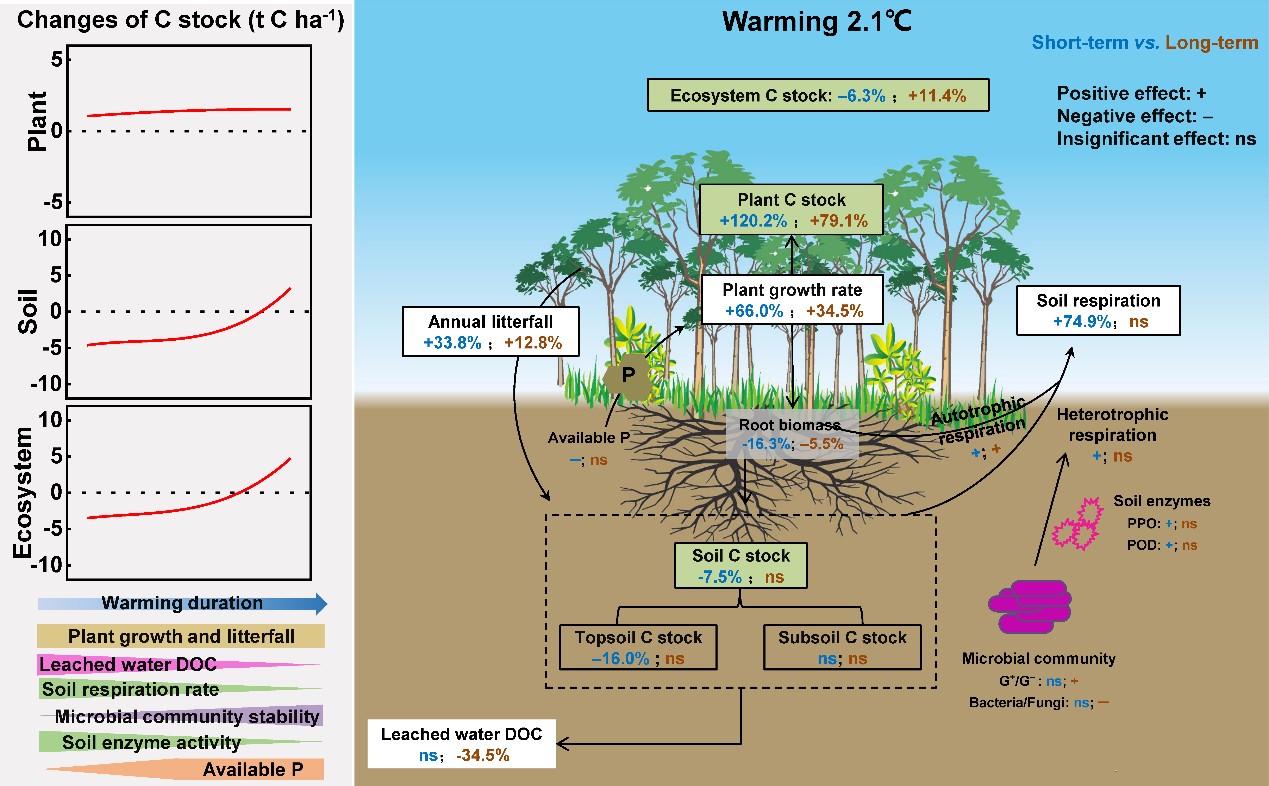Long-term warming increased carbon sequestration capacity in a humid subtropical forest
Tropical and subtropical forests play a crucial role in global carbon (C) pools, and their responses to warming can significantly impact C-climate feedback and predictions of future global warming. Despite earth system models projecting reductions in land C storage with warming, the magnitude of this response varies greatly between models, particularly in tropical and subtropical regions. Here, we conducted a field ecosystem-level warming experiment in a subtropical forest in southern China, by translocating mesocosms (ecosystem composed of soils and plants) across 600 m elevation gradients with temperature gradients of 2.1°C (moderate warming), to explore the response of ecosystem C dynamics of the subtropical forest to continuous 6-year warming. Compared with the control, the ecosystem C stock decreased by 3.8% under the first year of 2.1°C warming; but increased by 13.4% by the sixth year of 2.1°C warming. The increased ecosystem C stock by the sixth year of warming was mainly attributed to a combination of sustained increased plant C stock due to the maintenance of a high plant growth rate and unchanged soil C stock. The unchanged soil C stock was driven by compensating and offsetting thermal adaptation of soil microorganisms (unresponsive soil respiration andstable microbial community), increased plant C input, and inhibitory C loss (decreased C leaching and inhibited temperature sensitivity of soil respiration) from soil drying. These results suggest that the humid subtropical forest C pool would not necessarily diminish consistently under future long-term warming. We highlight that differential and asynchronous responses of plant and soil C processes over relatively long-term periods should be considered when predicting the effects of climate warming on ecosystem C dynamics of subtropical forests.
This research recently has been published in Global Change Biology (https://doi.org/10.1111/gcb.17072). Xujun Liu (Postdoctor from South China Botanical Garden) and Zhiyang Lie(Associate professor from South China Botanical Garden) were co-first authorship, Dr. Juxiu Liu (professor from South China Botanical Garden), is the corresponding author. This study was jointly funded by the Guangdong Flagship Project of Basic and Applied Basic Research , the National Natural Science Foundation of China, the Science and Technology Projects in Guangzhou, the China Postdoctoral Science Foundation, the Chinese Academy of Sciences and Spanish Government Grants funded by MCIN.
This paper is the fifth publication from this warming experiment in the Global Change Biologyl. Previous articles explored the responses of plant physiology (https://doi.org/10.1111/gcb.15355), nutrient nitrogen and phosphorus cycling (https://doi.org/10.1111/gcb.15432 and https://doi.org/10.1111/gcb.16194), and soil microbial community (https://doi.org/10.1111/gcb.16541) to long-term warming in the humid subtropical forest.
First author information: Zhiyang Lie: Associate researcher, Research Center for Ecology and Environmental Sciences, South China Botanical Garden, Chinese Academy of Science, Research field: Climate warming and biogeochemistry, E-mail: liezhiyang@scbg.ac.cn ; Tel :020-37252615

File Download: